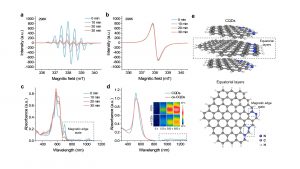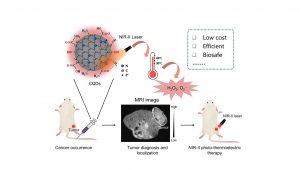A research team led by Chair Professor Tang Zikang and Distinguished Professor Sun Handong in the Institute of Applied Physics and Materials Engineering (IAPME) at the University of Macau (UM), in collaboration with a research team led by Chair Professor Chuxia Deng in the Faculty of Health Sciences (FHS), has developed novel carbon quantum dots (CQDs) that exhibit high electron spin and optical relaxation. These CQDs demonstrate exceptional magnetic resonance imaging (MRI) capabilities and excellent thermoelectric catalytic performance in the second near-infrared (NIR-II) window. This innovation proposes a novel, precise MRI-guided approach to NIR-II cancer phototherapy. The research has been published in the international journal Nature Communications.
CQDs are emerging as promising candidates in the field of nanomedicine. They exhibit behaviours related to electron spin, relaxation, and migration. Thanks to their excellent biocompatibility and low cytotoxicity, non-metallic CQDs are favoured for precision cancer therapy, which boasts high tumour targeting ability, potent tumour-killing efficacy, short treatment durations, and minimal side effects on the human body. The integration of therapeutic functionalities with MRI components is a promising goal for the clinical application of CQDs. Yet, the toxicity of Gd-based contrast agents (CAs) and the low relaxivity and stability of organic small molecule CAs restrict the clinical applications of current MRI CAs. Therefore, it is imperative to develop high-relaxivity carbon-based CAs, such as non-metallic CQDs. However, achieving phototherapy in the NIR-II window using MRI with non-metallic CQDs is highly challenging. In previous research, the research team addressed the issues of the low NIR-II absorption coefficient and optical conversion efficiency of CQDs through polaron engineering. Their findings were published in the prestigious journal Science Advances. The full version of the article is available at: https://www.science.org/doi/10.1126/sciadv.adn7896.
This study focuses on introducing magnetic edge states into CQDs to enable both MRI and NIR-II cancer treatment, thus demonstrating the potential of CQDs for precision cancer therapy. To this end, the research team synthesised highly paramagnetic CQDs using a bottom-up approach based on free radical polymerisation. Electron paramagnetic resonance spectroscopy and transient absorption spectra revealed the magnetic and optical properties, including the presence of fast spin and optical relaxation times of unpaired electrons between two edge nitrogen nuclei at room temperature. Controlling the electron relaxation and migration behaviour of the magnetic edge states enabled the CQDs to exhibit notable MRI T1 imaging ability (r₁ = 270 mM⁻¹s⁻¹) and NIR-II photo-thermoelectric catalytic properties in an aqueous soluation. Furthermore, combining CQDs with protein macromolecules resulted in the formation of protein coronas, enabling the passive enrichment of the CQDs in tumour tissues. Finally, the team successfully developed a precise MRI-guided approach to NIR-II cancer phototherapy. Through the synergistic control of structure, ligands, and environment, the team achieved electron relaxation and migration properties that surpass those of metallic materials. This provides a new paradigm for studying efficient spin averaging, hyperfine splitting, and zero-field splitting in carbon-based materials, thereby advancing the development of nanomedicine and spintronics.
The corresponding authors of the study are Prof Sun Handong, Prof Tang Zikang, Prof Chuxia Deng, and Zhang Tesen, a research assistant in IAPME. The first author is Tesen Zhang. The research project was funded by the Science and Technology Development Fund of the Macao SAR (File Nos.: 0128/2020/A3, 0131/2020/A3, 0007/2021/AKP, 006/2022/ALC, and 0139/2022/A3), the University of Macau (File Nos.: CPG2020-00026-IAPME, CPG2021-00034-IAPME, CPG2022-00013-IAPME, CPG2025-00034-IAPME, SRG2023-00025-IAPME, and MYRG2020-00164-IAPME), the Department of Science and Technology of Guangdong Province (File No.: 2022A0505030024), the Shenzhen-Hong Kong-Macao Science and Technology Innovation Project (Category C) (File No.: SGDX20210823103803021), and the Guangdong-Hong Kong-Macao Joint Laboratory for Photonic-Thermal-Electrical Energy Materials and Devices (File No.: EF010/IAPME-TZK/2020/GDSTC). The full text of the research article is available at: https://www.nature.com/articles/s41467-025-60951-7.
| Source: Institute of Applied Physics and Materials Engineering | |
| Media Contact Information: | |
| Communications Office, University of Macau | |
| Albee Lei | Tel: (853) 8822 8004 |
| Bell Leong | Tel: (853) 8822 8009 |
| Email: | prs.media@um.edu.mo |


